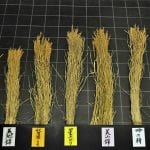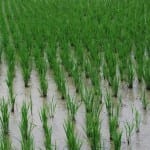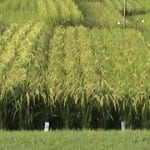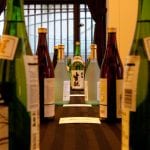What it is, and how much it’s used
 If you have gotten this far – getting to this blog – then you surely know that sake is made from rice. So let’s start with that base assumption. No other fermentable material is used: no sugar, no grains. But much changes in the sake world, which is not always so proactive in presenting information to begin with. So let’s look at a handful of fun and interesting observations about rice and how it is used in the sake world.
If you have gotten this far – getting to this blog – then you surely know that sake is made from rice. So let’s start with that base assumption. No other fermentable material is used: no sugar, no grains. But much changes in the sake world, which is not always so proactive in presenting information to begin with. So let’s look at a handful of fun and interesting observations about rice and how it is used in the sake world.
First of all, there is sake rice and then there is everything else, rice-wise. Sake rice is known as shuzo koteki-mai, or less officially, sakamai. Often, regular rice is referred to as table rice. Shuzo Koteki-mai is a legal definition, i.e. there are officially registered sake rice varieties; not just any rice that aspires to it can in fact be a sake rice. There are physical differences.
Just about four percent of all rice grown in Japan is sake rice. And this is split across about one hundred varieties. About. It goes up and down a bit each year as new ones are tried and old ones fall off the list. And, much like grapes, if you know about a dozen, you are amongst most cognoscenti. But in truth, knowing about half that number will serve you well in eighty percent of premium sake situations you encounter.
But here is the thing: most sake is actually not made from proper sake rice.
 Looking at the breakdown of the sake market, about 35 percent is considered premium, which means it qualifies for a special designation. What special designations would those be? Honjozo, junmai-shu, and the four types of ginjo. The remaining 65 percent does not qualify for those terms, and that 65 percent is considered just regular sake. Note, much of it is very enjoyable! ‘Tis not to be dissed, at least not outright. But the point here is that this 65 percent of all sake produced is not made with sake rice, but rather run-of-the-mill table rice.
Looking at the breakdown of the sake market, about 35 percent is considered premium, which means it qualifies for a special designation. What special designations would those be? Honjozo, junmai-shu, and the four types of ginjo. The remaining 65 percent does not qualify for those terms, and that 65 percent is considered just regular sake. Note, much of it is very enjoyable! ‘Tis not to be dissed, at least not outright. But the point here is that this 65 percent of all sake produced is not made with sake rice, but rather run-of-the-mill table rice.
However, almost all premium sake is made using sake rice. Doing so leads to much better sake with much less effort. Note, however, that this is not a law or even a rule. It is not at all obligatory to use sake rice for any sake, not even lofty daiginjo.
Why would a brewer not do so? Simple: cost. Sake rice is two to three times more expensive than normal rice, especially after some special rice-pricing breaks the distribution system allows sake brewers to utilize. So cost is huge. Another reason could be availability. In a low-yield year, there just might not be enough good sake rice to go around.
But for all intents and purposes, premium sake is in fact made using proper sake rice, whereas cheap sake generally is not.
As mentioned above, sake rice and table rice are physically different. Sake rice is larger: the grains themselves and the plants as well. Sake rice has  more starch, and less fat and protein. Starch becomes sugar; sugar becomes alcohol. So more starch is good. You can eat sake rice, but that extra fat and protein make table rice taste better.
more starch, and less fat and protein. Starch becomes sugar; sugar becomes alcohol. So more starch is good. You can eat sake rice, but that extra fat and protein make table rice taste better.
Sake rice also has those desirable starches physically located in the center of the grains, with fat and protein around that, near the surface. This makes it easy to mill away the outside of the grain and take that fat and protein away, leaving starch behind.
It is harder to grow, or at least to grow well. It calls for more effort and specific climactic conditions. And all these factors combine to make sake rice more expensive as well.
As mentioned above, there are about 100 varieties of sake rice registered. About. The most commonly encountered – and widely considered the best – is Yamada Nishiki. Other names to learn and remember are Gohyakumangoku, Miyama Nishiki, Omachi, and Hattan Nishiki. There are many more, but this small sampling will be found in much of the sake you enjoy. Still, you will encounter dozens of others if you pay attention to such things.
 Rarely are they blended. Most often a given sake is made with one rice only. There are, of course, exceptions. One such exception is that sometimes Yamada Nishiki is used for the koji (the 20 percent of all the rice in a given batch that has enzyme-producing mold propagated onto it) since koji exerts the most leverage on the nature of the sake. A less expensive sake rice can be used for the remaining 80 percent, onto which the mold is not grown.
Rarely are they blended. Most often a given sake is made with one rice only. There are, of course, exceptions. One such exception is that sometimes Yamada Nishiki is used for the koji (the 20 percent of all the rice in a given batch that has enzyme-producing mold propagated onto it) since koji exerts the most leverage on the nature of the sake. A less expensive sake rice can be used for the remaining 80 percent, onto which the mold is not grown.
This method walks that fine line of quality and cost control, and walks it nicely. But again, it is not so commonly done. You could say that those that do it are going “against the grain.” (Sorry.)
An important concept related to sake and rice is that the choice of rice does not affect the final flavor and nature of the sake in quite the same way that the choice of grape might affect the nature and flavors of a wine. Yes, the choice of rice is very important. And yes, different rice varieties do lead to flavor profiles that can be associated with them – in general. But two toji (master brewers) can take the same rice, milled to the same degree, and make totally different sake in every way.
How? By creating the koji differently, or through the choice of yeast, or fermentation temperature or time in the tank. There are dozens of options at every step of the brewing process, and those choices hugely affect the nature of the sake. More so than the choice of rice? Perhaps; perhaps not. It depends on who you ask.
But using proper sake rice – and carefully selecting the right one for the job – is still a massively leveraging and important aspect of making great sake. Why? Because good sake rice allows a toji to express his or her skills through the sake. Proper sake rice lets the toji do his or her best work. It is predictable in how it behaves, and just which one is best depends on the style of sake, the region, and the experience of those that will handle it.
There is much, much more to be said about sake rice. There are trends, economics, politics, developments, history, culture and climate changes. Nothing ever sits still in the sake world.
But we can. We can sit still and enjoy the sake in front of us. That’s all we really need to do: enjoy sake. However, should it interest us, we can also begin to pay attention and take notes about rice types and the lore that surrounds each. It certainly enhances sake enjoyment.
Sake Professional Course in San Francisco, April 3 ~ 5, 2017
 From Monday, April 3 until Wednesday April 5, I will hold the first Sake Professional Course of 2017 at Bentley Reserve in San Francisco. If interested, for more information please send me an email at sakeguy@gol.com. “No sake stone remains left unturned” in this very comprehensive course. Learn more here.
From Monday, April 3 until Wednesday April 5, I will hold the first Sake Professional Course of 2017 at Bentley Reserve in San Francisco. If interested, for more information please send me an email at sakeguy@gol.com. “No sake stone remains left unturned” in this very comprehensive course. Learn more here.




